Modeling Wastewater Treatment Plants to Study Energy Optimal Control
Abstract
1. Introduction
2. The Case Study of Płaszów WWTP
2.1. General Overview of WWTP
2.2. Aeration Installation
3. The Model of Blowers Inspired by Płaszów WWTP
3.1. Model of the Aeration System
- The aeration controller, which reads the airflowdemand and defines the level of utilization (Lutilization) of the blowers using a predetermined control rule.
- The model of the blowers that reads Lutilization of each blower from the controller and calculates airflowgenerated and powermomentary of the blowers.
3.2. Aeration Controller
- All blowers running at Lutilization = 0 still produce too much air.
- At least one has been operating with Lutilization = 0 for a user-defined TOFFdelay time span.
- At least two blowers are active.
- In the event that all these three conditions are met, the blower with the longest operating time is stopped:
- All the active blowers are running with Lutilization = 1.
- The lastly activated blower has been operating with Lutilization = 1 for at least a user-defined TONdelay time span.
- No more than three blowers are already active, so that the maximum number of active blowers never exceeds four.
3.3. Blowers’ Performance Model
4. Simulation of the Blower’s Operation
4.1. Definition of Tests Performed During Simulations
- The blower that has not been working for the longest period of time (Section 4.2).
- According to a priority level based on the blowers’ performance (Section 4.3).
4.2. Start-Up of Blowers with the Longest Downtime
4.3. Selection of Blowers Determined by Their Working Efficiency
4.4. Influence of Blowers’ Delay Times on Power Consumption
5. Summary
Author Contributions
Funding
Data Availability Statement
Conflicts of Interest
References
- Li, D.; Zou, M.; Jiang, L. Dissolved oxygen control strategies for water treatment: A review. Water Sci. Technol. 2022, 86, 1444–1466. [Google Scholar] [CrossRef] [PubMed]
- Masłon, A.; Czarnota, J.; Szaja, A.; Szulzyk-Cieplak, J.; Łagód, G. The enhancement of energy efficiency in a wastewater treatment plant through sustainable biogas use: Case study from Poland. Energies 2020, 13, 6056. [Google Scholar] [CrossRef]
- Panepinto, D.; Fiore, S.; Zappone, M.; Genon, G.; Meucci, L. Evaluation of the energy efficiency of a large wastewater treatment plant in Italy. Appl. Energy 2016, 161, 404–411. [Google Scholar] [CrossRef]
- Liu, C.; Li, S.; Zhang, F. The oxygen transfer efficiency and economic cost analysis of aeration system in municipal wastewater treatment plant. Energy Procedia 2011, 5, 2437–2443. [Google Scholar] [CrossRef]
- Gu, Y.; Li, Y.; Li, X.; Luo, P.; Wang, H.; Wang, X.; Wu, J.; Li, F. Energy Self-sufficient Wastewater Treatment Plants: Feasibilities and Challenges. Energy Procedia 2017, 105, 3741–3751. [Google Scholar] [CrossRef]
- Król, P.; Gallina, A.; Uhl, T. Sewage influent estimation in BSM1 model of Płaszów WWTP. In Proceedings of the IDAACS’2021, Cracow, Poland, 22–25 September 2021. [Google Scholar] [CrossRef]
- Król, P.; Gallina, A.; Lubieniecki, M.; Uhl, T.; Żaba, T. Sensitivity analysis of a municipal wastewater treatment plant model. MATEC Web Conf. 2019, 252, 05010. [Google Scholar] [CrossRef]
- Piotrowski, R.; Ujazdowski, T. Model of Aeration System at Biological Wastewater Treatment Plant for Control Design Purposes. In Advances in Intelligent Systems and Computing; Springer: Berlin/Heidelberg, Germany, 2020; pp. 349–359. [Google Scholar] [CrossRef]
- Pöyry, L.; Ukkonen, P.; Mulas, M.; Mikola, A. Modelling solution for estimating aeration energy of wastewater treatment plants. Water Sci. Technol. 2021, 84, 3941–3951. [Google Scholar] [CrossRef] [PubMed]
- Amerlinck, Y.; De Keyser, W.; Gorka, U.; Nopens, I. A realistic dynamic blower energy consumption model for wastewater applications. Water Sci. Technol. 2016, 74, 1561–1576. [Google Scholar] [CrossRef] [PubMed]
- Vergara-Araya, M.; Hilgenfeldt, V.; Peng, D.; Steinmetz, H.; Wiese, J. Modelling to lower energy consumption in a large wwtp in china while optimising nitrogen removal. Energies 2021, 14, 5826. [Google Scholar] [CrossRef]
- Gu, Y.; Li, Y.; Yuan, F.; Yang, Q. Optimization and control strategies of aeration in WWTPs: A review. J. Clean. Prod. 2023, 418, 138008. [Google Scholar] [CrossRef]
- Nguyen, D.H.; Latifi, M.A.; Lesage, F.; Mulholland, M. Dynamic simulation and optimization of wastewater treatment plants. In Proceedings of the 2013 International Conference on Process Control (PC), Štrbské Pleso, Slovakia, 18–21 June 2013; pp. 407–414. [Google Scholar] [CrossRef]
- Li, X.; Jing, Y.; Olsson, G.; Yuan, Z. Finding the optimal aeration profiles and do profiles in a plug-flow biological wastewater treatment reactor with a theoretical approach. IFAC Proc. Vol. (IFAC-PapersOnline) 2014, 19, 2715–2720. [Google Scholar] [CrossRef]
- Tzoneva, R. Optimal PID control of the dissolved oxygen concentration in the wastewater treatment plant. In Proceedings of the AFRICON 2007, Windhoek, Namibia, 26–28 September 2007; pp. 1–7. [Google Scholar] [CrossRef]
- Åmand, L.; Carlsson, B. Aeration control with gain scheduling in a full-scale wastewater treatment plant. IFAC Proc. Vol. (IFAC-PapersOnline) 2014, 47, 7146–7151. [Google Scholar] [CrossRef]
- Piotrowski, R.; Zawadzki, A. Multiregional PI control strategy for dissolved oxygen and aeration system control at biological wastewater treatment plant. In Proceedings of the 2012 IEEE 17th International Conference on Emerging Technologies & Factory Automation (ETFA 2012), Krakow, Poland, 17–21 September 2012; pp. 1–8. [Google Scholar] [CrossRef]
- Han, Y.; Brdys, M.A.; Piotrowski, R. Nonlinear PI control for dissolved oxygen tracking at wastewater treatment plant. IFAC Proc. Vol. 2008, 41, 13587–13592. [Google Scholar] [CrossRef]
- Dainotto, A.; Barni, G.; Giaccherini, F.; Magnolfi, V.; Marsili-Libelli, S.; Simonetti, I. A multilevel coordinated control strategy for energy conservation in wastewater treatment plants. IFAC Proc. Vol. 2012, 45, 288–293. [Google Scholar] [CrossRef]
- Mulas, M.; Corona, F.; Sirvio, J.; Hyvonen, S.; Vahala, R. Full-scale implementation of an advanced control system on a biological wastewater treatment plant. IFAC-PapersOnLine 2016, 49, 1163–1168. [Google Scholar] [CrossRef]
- Mulas, M.; Tronci, S.; Corona, F.; Haimi, H.; Lindell, P.; Heinonen, M.; Vahala, R.; Baratti, R. Predictive control of an activated sludge process: An application to the Viikinmäki wastewater treatment plant. Process Control 2015, 35, 89–100. [Google Scholar] [CrossRef]
- Krawczyk, W.; Piotrowski, R.; Brdys, M.A.; Chotkowski, W. Modelling and Identification of Aeration Systems for Model Predictive Control of Dissolved Oxygen—Swarzewo Wastewater Treatment Plant Case Study. IFAC Proc. Vol. 2007, 40, 43–48. [Google Scholar] [CrossRef]
- Smith, R. How to Control Activated Sludge with Online Sensors. 2013. Available online: https://www.xylem.com/siteassets/brand/wtw/resources/white-papers/wtw-how-to-control-activated-sludge-with-online-sensors.pdf (accessed on 2 November 2025).
- de Canete, J.; del Saz-Orozco, P.; Garcia-Moral, I. Aeration Control and Parameter Soft Estimation for a Wastewater Treatment Plant Using a Neurogenetic Design, in Advances. In Computational Intelligence; Springer: Berlin/Heidelberg, Germany, 2011; pp. 315–322. [Google Scholar] [CrossRef]
- Monday, C.; Zaghloul, M.S.; Krishnamurthy, D.; Achari, G. A Review of AI-Driven Control Strategies in the Activated Sludge Process with Emphasis on Aeration Control. Water 2024, 16, 305. [Google Scholar] [CrossRef]
- Kudłacz, T.; Musiał-Malago, M. Funkcjonalne Miasto w Teorii i Praktyce na Przykładzie Krakowa i Krakowskiego Obszaru Metropolitarnego. 2018. Available online: https://wydawnictwo.uek.krakow.pl/images/pdf/kudlacz-musial-malago-funkcjonalne-miasto.pdf (accessed on 28 August 2024).
- Opis Projektu—Oczyszczalnia Ścieków Płaszów II w Krakowie. Available online: https://wodociagi.krakow.pl/pl/projekty/projekty-unijne/oczyszczalnia-sciekow-plaszow-ii-w-krakowie (accessed on 25 September 2025).
- Dyrektywa Rady z Dnia 21 Maja 1991 r. Dotycząca Oczyszczania Ścieków Komunalnych (91/271/EWG), 1991. Available online: https://orka.sejm.gov.pl/Drektywy.nsf/all/31991L0271/$File/31991L0271.pdf (accessed on 2 November 2025).
- HV-TURBO® Centrifugal Turbo Compressor. Available online: https://files.chartindustries.com/Howden_HVTurbo_Brochure.pdf (accessed on 2 November 2025).
- Biedrzycka, A. Kierunek: Pasywna oczyszczalnia Płaszów. Nowoczesne Budownictwo Inżynieryjne, November-December 2016, pp. 14–17. Available online: https://nbi.com.pl/content/uploads/assets/NBI-pdf/2016/6_69_2016/Pdf/4_MPWiK_Krakow.pdf (accessed on 2 November 2025).




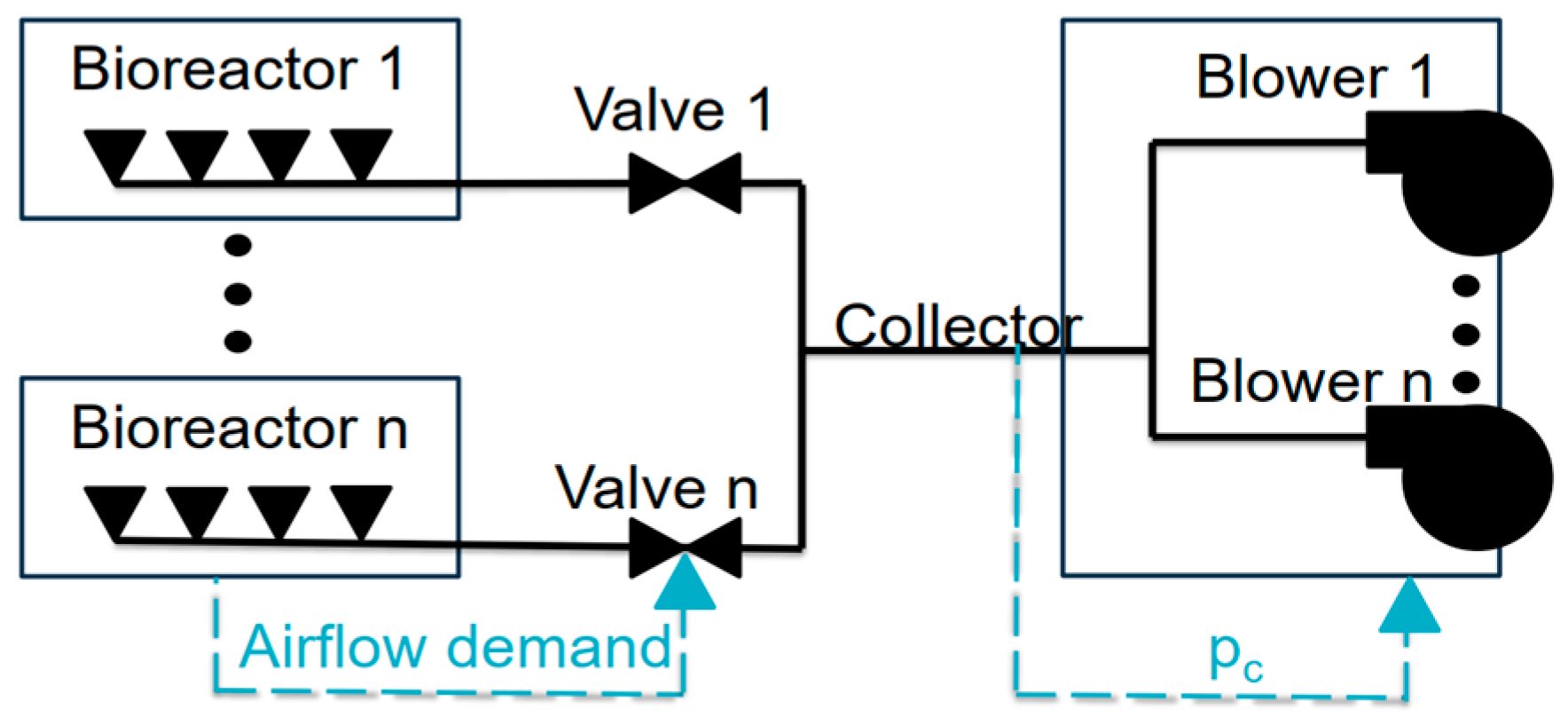



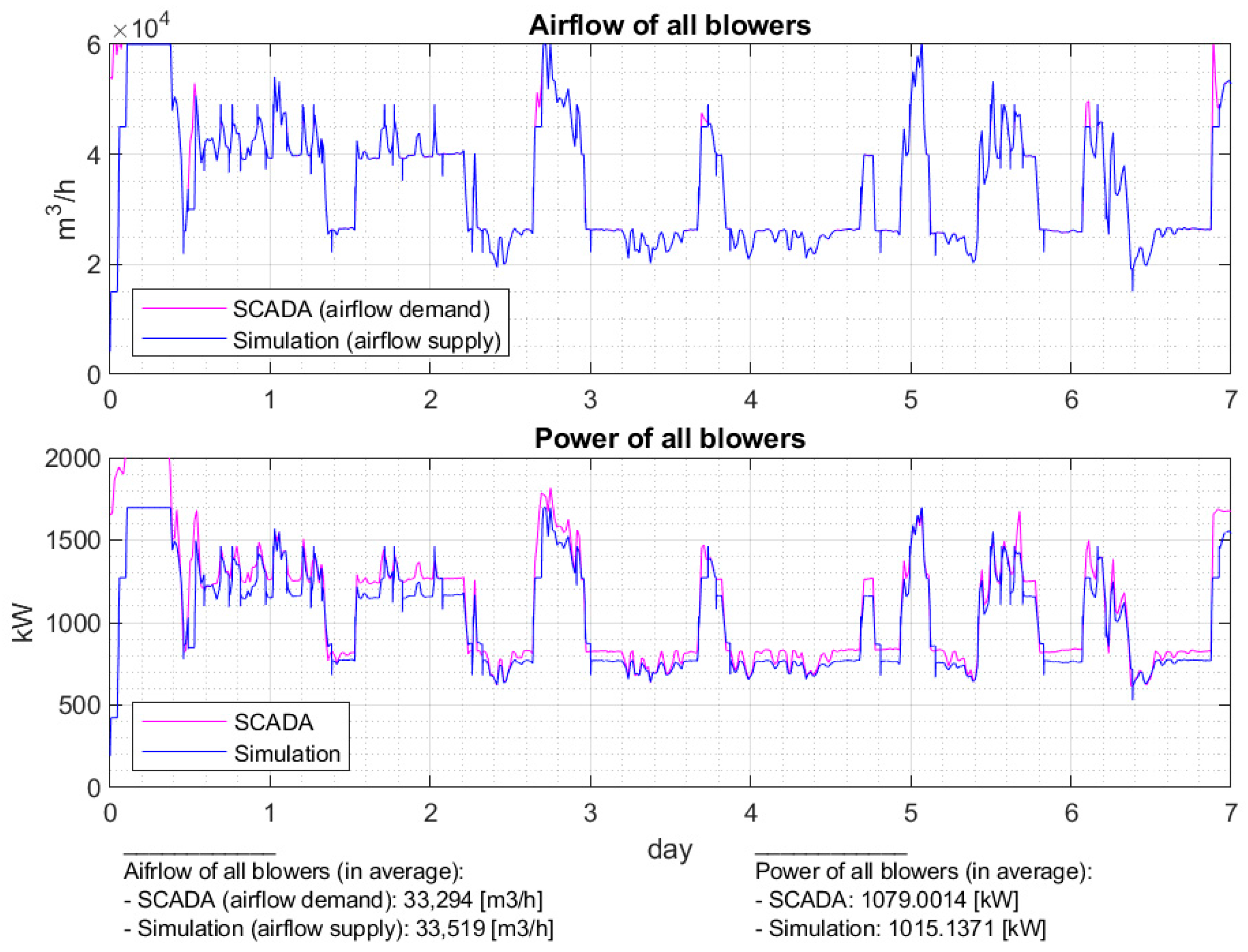
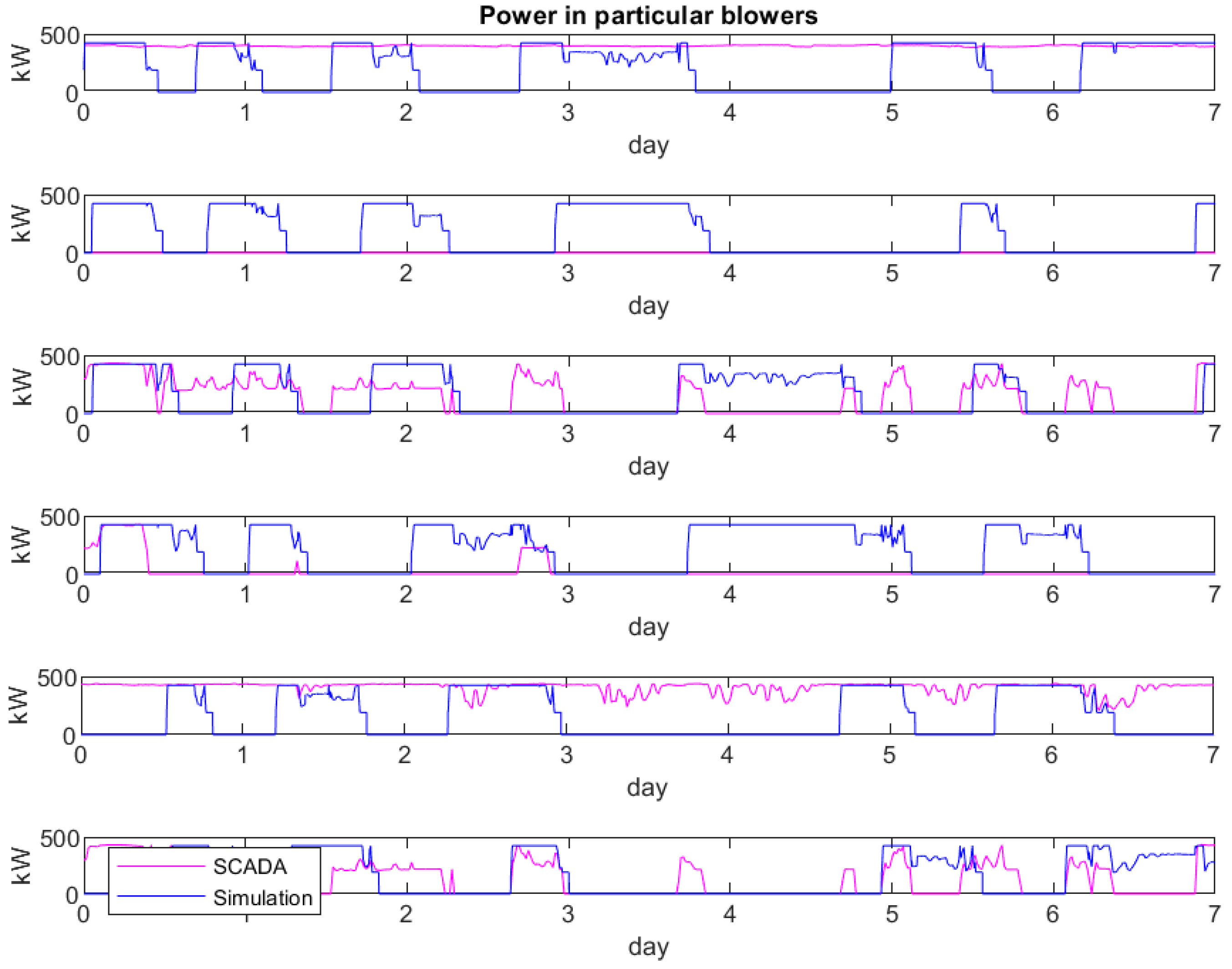
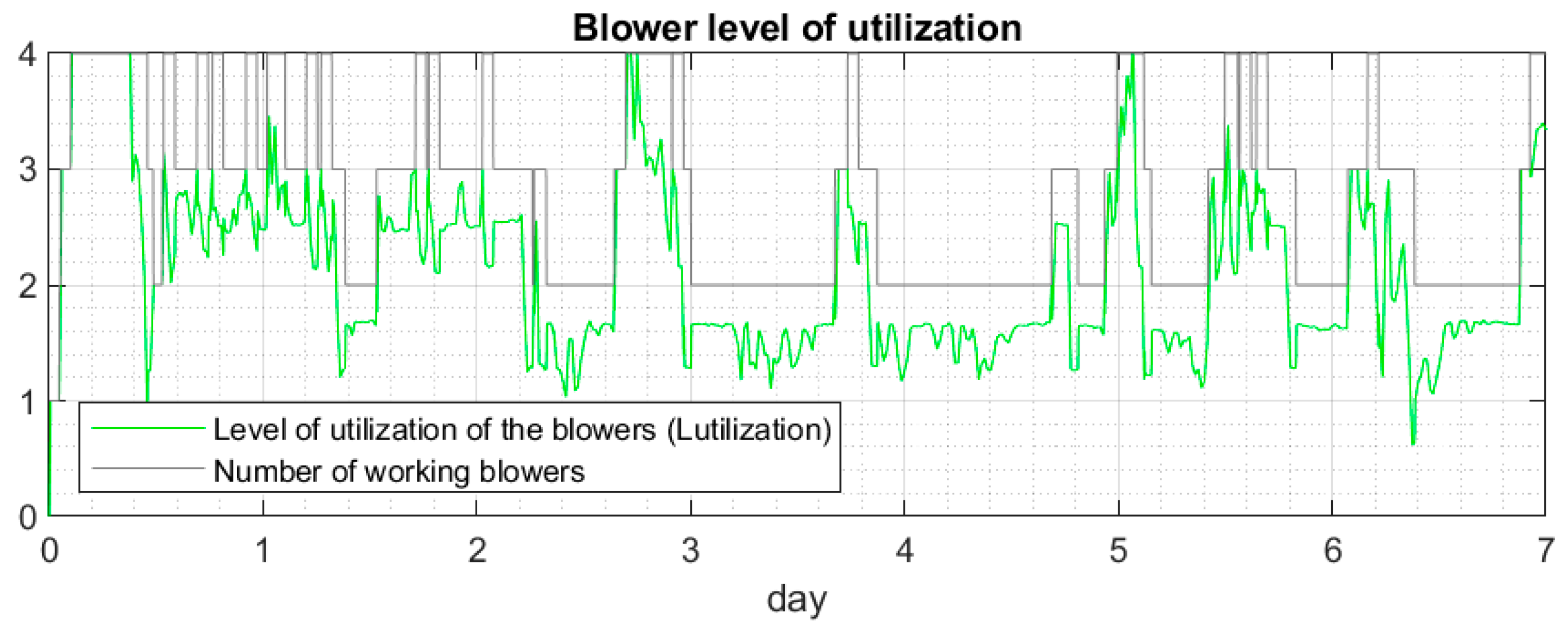
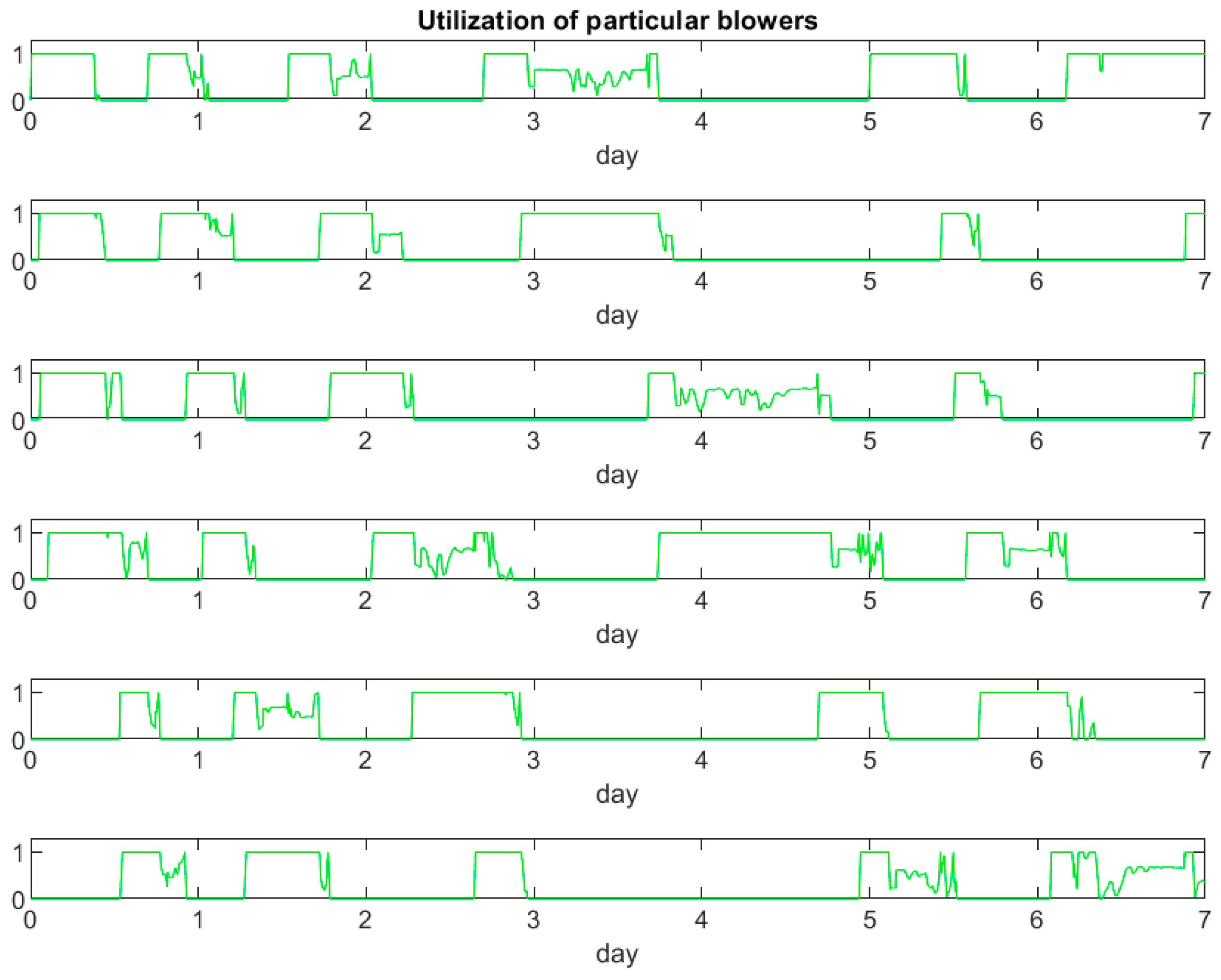


| Parameter | Expected Value of Parameter in mg/L (According to 91/271/EWG [28] in Płaszów WWTP [27]) |
|---|---|
| BOD5 | 15 |
| COD | 125 |
| Total suspended solids | 35 |
| Total nitrogen | 10 |
| Total phosphorus | 1.0 |
| Blower | Equation Estimated for Particular Blower | Extreme Flowrates [m3/h] | Extreme Powers [kW] | ||
|---|---|---|---|---|---|
| Minimum | Maximum | Minimum | Maximum | ||
| 1 | y = 0.025 ⋅ x + 61.926 | 10,749 | 13,825 | 330.6510 | 407.5510 |
| 2 | y = 0.0214 ⋅ x + 103.35 | 4217 | 14,998 | 193.5938 | 424.3072 |
| 3 | y = 0.0209 ⋅ x + 79.379 | 3547 | 17,713 | 153.5113 | 449.5807 |
| 4 | y = 0.0177 ⋅ x + 108.9 | 5029 | 19,799 | 197.9133 | 459.3423 |
| 5 | y = 0.0303 ⋅ x + 34.391 | 4788 | 14,761 | 179.4674 | 481.6493 |
| 6 | y = 0.0209 ⋅ x + 79.379 | 3547 | 17,713 | 153.5113 | 449.5807 |
| Blower Nr.: | 1 | 2 | 3 | 4 | 5 | 6 |
|---|---|---|---|---|---|---|
| Priority: | 1/0.03027 | 1/0.03117 | 1/0.03223 | 1/0.2967 | 1/0.03363 | 1/0.3223 |
| TONdelay | TOFFdelay | Power of All Blowers [kW] |
|---|---|---|
| 15 min | 15 min | 1011.75 |
| 15 min | 30 min | 1019.07 |
| 15 min | 60 min | 1029.61 |
| 30 min | 15 min | 1005.45 |
| 30 min | 30 min | 1012.96 |
| 30 min | 60 min | 1024.28 |
| 60 min | 15 min | 993.32 |
| 60 min | 30 min | 1002.48 |
| 60 min | 60 min | 1015.14 |
Disclaimer/Publisher’s Note: The statements, opinions and data contained in all publications are solely those of the individual author(s) and contributor(s) and not of MDPI and/or the editor(s). MDPI and/or the editor(s) disclaim responsibility for any injury to people or property resulting from any ideas, methods, instructions or products referred to in the content. |
© 2025 by the authors. Licensee MDPI, Basel, Switzerland. This article is an open access article distributed under the terms and conditions of the Creative Commons Attribution (CC BY) license (https://creativecommons.org/licenses/by/4.0/).
Share and Cite
Król, P.; Małka, P.; Gallina, A.; Kasprzyk, K. Modeling Wastewater Treatment Plants to Study Energy Optimal Control. Energies 2025, 18, 6011. https://doi.org/10.3390/en18226011
Król P, Małka P, Gallina A, Kasprzyk K. Modeling Wastewater Treatment Plants to Study Energy Optimal Control. Energies. 2025; 18(22):6011. https://doi.org/10.3390/en18226011
Chicago/Turabian StyleKról, Paweł, Piotr Małka, Alberto Gallina, and Kamil Kasprzyk. 2025. "Modeling Wastewater Treatment Plants to Study Energy Optimal Control" Energies 18, no. 22: 6011. https://doi.org/10.3390/en18226011
APA StyleKról, P., Małka, P., Gallina, A., & Kasprzyk, K. (2025). Modeling Wastewater Treatment Plants to Study Energy Optimal Control. Energies, 18(22), 6011. https://doi.org/10.3390/en18226011






